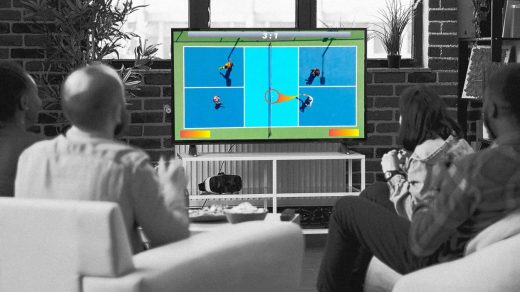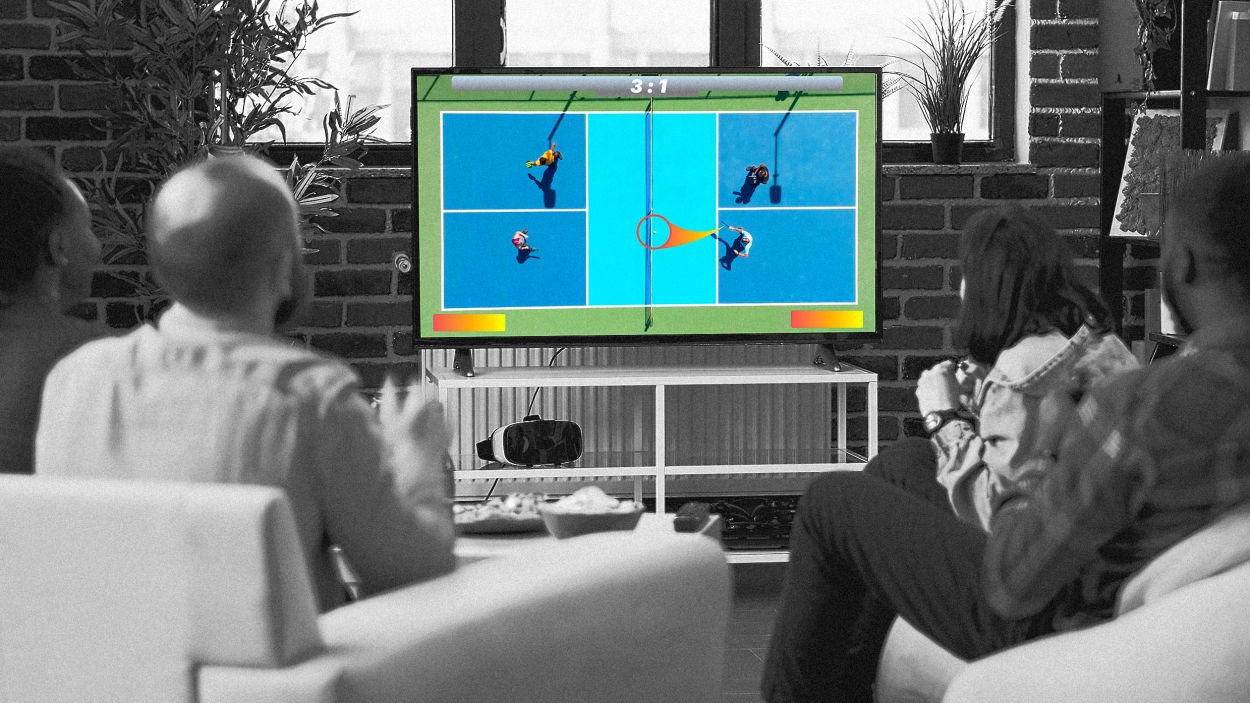6 ways broadcast pickleball is changing the sport for regular dinkers
By Ashwin Rodrigues
Americans’ enthusiasm for playing pickleball isn’t yet translating to large audiences for televised pickleball, as Morning Consult reported in March. But the major pickleball leagues—there are several—remain optimistic that the sport will keep gaining viewers, and that it’ll drive more people to get on a court themselves. When they get there, things might look different than they did before. Fast Company spoke to some of the people involved with the sport at its highest levels to understand how broadcasting is already changing the very nature of the game.
Pickleball has faces now
Most pickleball players can’t name more than few professional pickleballers, if they can name any at all, admits Tom Webb, chief marketing officer for the Association of Pickleball Professionals (APP), one of the sport’s two professional pickleball tours. (Webb’s a pro sports vet, having done marketing and communications for U.S. Ski & Snowboard and Austin FC, a Major League Soccer club.) But that’s starting to change.
Pickleball had initially been relying heavily on outside celebrities to bring in viewers—Stephen Colbert hosted a celeb-packed pickleball tournament last year, and ESPN broadcasted a slam between former tennis legends including John McEnroe and Andre Agassi in April. It’s a tactic similar to one used to grow Major League Soccer: English footballer David Beckham joined the LA Galaxy n 2007 in an effort to help grow the beautiful game stateside. It was so effective it now has a name: The “Beckham effect.”
But now, actual pickleball players are becoming the stars in their own arena, among them WNBA star Jewel Lloyd, who is aiming to go pro in the APP sometime in the next year. Their profiles are on the rise largely thanks to efforts by major leagues such as the APP, Major League Pickleball (MLP), and the Professional Pickleball Association (PPA). These leagues are very focused on image—the APP works with Emmy-award winning Intersport to produce its coverage—and do things like facilitate mini tutorials, where professionals, such as the #1 ranked PPA men’s pro Ben Johns, provide tips to inquisitive amateurs on Twitter, including Bill Gates. And they are beginning to think like storytelling, making sure that when drama unfolds on the court, clips are replayed on YouTube and discussed on social media.
Leagues also book pro athletes on pickleball podcasts, where they can unpack rivalries. Players address illegal paddle controversies on Instagram, and provide technical tips on YouTube. All of this offers multiple entry points for average players, so that they can stay engaged with the game.
The spectacle of pickleball is still “fairly new,” said Tim Bunnell, ESPN’s senior vice president of programming and acquisitions in charge of network’s racket sports deals. “You can get by for a period of time on just the novelty of it,” he said. But as professional pickleball grows and rivalries develop, “you’re going to need production values to buttress and further those storylines along.”
The venues are evolving
Pickleball broadcasts sometimes suffer from the “Keystone effect,” Webb said, referring to the flattening of depth that sometimes occurs during broadcast.
Because of this, pickleball-specific venues with broadcast capabilities are increasing in popularity. Venues with one main “championship” court, outfitted with lights and plenty of spectator seating, are popping up, including Pictona, the Daytona, Florida, venue with 49 pickleball courts and one championship court. Pictona hosted the APP’s first tournament for the 2023 season, where 1,400 participants (mostly amateur) played among a small group of APP tour pros.
Recreational players aren’t just limited to their regular pickleball courts, either. New hybrid businesses are enabling them to gather in similarly large and creative ways. Chicken-N-Pickle, for example, offers food, drink, and pickleball all under one roof.
The play is more strenuous
As the sport has evolved, it’s become more physical and draining. With millions of dollars in prize money being awarded every year, the gameplay no longer looks like two retired dentists trying to fulfill their weekly exercise quota. It’s a faster-paced game now, with athletes traveling with personal trainers and sometimes even administering IVs between matches, according to Hannah Johns, who is—curiously— both a TV reporter and director of public relations for the Pickleball Professionals Association, a major pickleball league founded in 2018. (She is also the sister of Ben Johns.) And maybe not just IVs: multiple pros have called for a PED testing protocol to ensure the sport isn’t incorporating the wrong juice.
“The pros are incredible to watch,” Johns says. Amateurs are inspired to up their game. Hence the need for those YouTube tutorials from pros such as the PPA’s Tyson McGuffin.
The clothes are better
Professional pickleball players know they’re on display, so they’re showing up looking extra presentable, to audiences and potential sponsors. Clothing brands know that they’ve got more eyeballs on them, too and acting accordingly. In the past few years, companies like Nike and Fila have released pickleball specific athleticwear and footwear. (So has Norma Kamali.) It’s a calculated decision: on average, people who play pickleball recreationally earn more than $100,000 a year.
Somewhat surprisingly, the standout apparel brand in pickleball is, by far, Skechers, which sponsors two of the top players: Tyler McGuffin and Catherine Parenteau, while also holding the title of official footwear sponsor for the PPA. It might be the coolest thing to happen to Skechers since Kim Kardashian promoted its allegedly butt-toning Shape-up sneakers during the 2011 Super Bowl. (Sketchers settled with the Federal Trade Commission for $40 million for deceptive advertising.)
A report by Cowen in January revealed that Skechers is gaining market share from Nike and Adidas with the demographic that makes up a huge chunk of the pickleball pie: wealthy boomers.
Emotions are amplified
Webb says that the Association of Pickleball Professionals employs an entire team of people whose job it is advise pro pickleball players on ways they can generate bigger audiences. This player liaison team helps athletes adapt their game for broadcast, coaching them on how to be more vocal and assertive on the court, while carrying the same energy to social media and interacting with fans. Theatrics are now an expected part of matches, complete with yelling, heated exchanges with referees, and occasionally, overeager fans interrupting play. Social media highlights show players screaming in both victory and defeat, and sometimes emotions can run high.
And as some players know firsthand, it’s much more difficult to smash a pickleball paddle than a tennis racket. In March, a PPA player named DJ Young threw his paddle to the ground in frustration during a semifinals doubles match, and it ricocheted into the audience. Fortunately, nobody was injured, but Young still made history: he became the first professional pickleball player to be fined for in-game misconduct. Young immediately apologized for his behavior, and apologized again in an Instagram post.
If your pickleball-obsessed uncle has suddenly turned into John MacEnroe, don’t blame him. He might just be emulating what he saw on TV.
There’s money on the lines
Scoring for pickleball historically relied on the honors system, which is no longer sufficient when hundreds of thousands of dollars are at stake. The PPA tour now uses six cameras for its main court; a backup human referee watches replays of disputed calls in a truck off-court to judge line call challenges.
But there’s another impending reason pros can’t be trusted to call their own shots. The PPA commissioner, Connor Pardoe, said in March that gambling would be officially part of pickleball as soon as May, following a 2021 partnership with Genius Sports, the platform that provides its sports tech data such betting giants as DraftKings. The ability to wager on the outcome of pickleball would bring in a new set of participants: those who like to gamble but don’t necessarily care about America’s fastest growing sport. Two-way parlays or not, Big Pickleball is trying lots of different ways to keep the sport enticing for existing players and fans, while attracting new ones.
(14)



